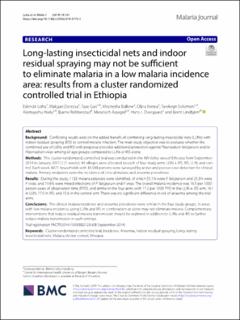| dc.contributor.author | Loha, Eskindir | |
| dc.contributor.author | Deressa, Wakgari | |
| dc.contributor.author | Ayana, Taye Gari | |
| dc.contributor.author | Balkew, Meshesha | |
| dc.contributor.author | Kenea, Oljira | |
| dc.contributor.author | Shanka, Tarekegn Solomon | |
| dc.contributor.author | Hailu, Alemayehu | |
| dc.contributor.author | Robberstad, Bjarne | |
| dc.contributor.author | Roro, Meselech Assegid | |
| dc.contributor.author | Overgaard, Hans Jørgen | |
| dc.contributor.author | Lindtjorn, Bernt | |
| dc.date.accessioned | 2020-10-29T10:06:55Z | |
| dc.date.available | 2020-10-29T10:06:55Z | |
| dc.date.created | 2019-08-03T11:59:58Z | |
| dc.date.issued | 2019 | |
| dc.identifier.citation | Malaria Journal. 2019, 18:141 1-15. | en_US |
| dc.identifier.issn | 1475-2875 | |
| dc.identifier.uri | https://hdl.handle.net/11250/2685652 | |
| dc.description.abstract | Background Conflicting results exist on the added benefit of combining long-lasting insecticidal nets (LLINs) with indoor residual spraying (IRS) to control malaria infection. The main study objective was to evaluate whether the combined use of LLINs and IRS with propoxur provides additional protection against Plasmodium falciparum and/or Plasmodium vivax among all age groups compared to LLINs or IRS alone. Methods This cluster-randomized, controlled trial was conducted in the Rift Valley area of Ethiopia from September 2014 to January 2017 (121 weeks); 44 villages were allocated to each of four study arms: LLIN + IRS, IRS, LLIN, and control. Each week, 6071 households with 34,548 persons were surveyed by active and passive case detection for clinical malaria. Primary endpoints were the incidence of clinical malaria and anaemia prevalence. Results During the study, 1183 malaria episodes were identified, of which 55.1% were P. falciparum and 25.3% were P. vivax, and 19.6% were mixed infections of P. falciparum and P. vivax. The overall malaria incidence was 16.5 per 1000 person-years of observation time (PYO), and similar in the four arms with 17.2 per 1000 PYO in the LLIN + IRS arm, 16.1 in LLIN, 17.0 in IRS, and 15.6 in the control arm. There was no significant difference in risk of anaemia among the trial arms. Conclusions The clinical malaria incidence and anaemia prevalence were similar in the four study groups. In areas with low malaria incidence, using LLINs and IRS in combination or alone may not eliminate malaria. Complementary interventions that reduce residual malaria transmission should be explored in addition to LLINs and IRS to further reduce malaria transmission in such settings. Trial registration PACTR201411000882128 (08 September 2014) | en_US |
| dc.language.iso | eng | en_US |
| dc.relation.uri | https://doi.org/10.1186/s12936-019-2775-1 | |
| dc.rights | Navngivelse 4.0 Internasjonal | * |
| dc.rights.uri | http://creativecommons.org/licenses/by/4.0/deed.no | * |
| dc.title | Long-lasting insecticidal nets and indoor residual spraying may not be sufficient to eliminate malaria in a low malaria incidence area: Results from a cluster randomized controlled trial in Ethiopia | en_US |
| dc.type | Peer reviewed | en_US |
| dc.type | Journal article | en_US |
| dc.description.version | publishedVersion | en_US |
| dc.source.pagenumber | 1-15 | en_US |
| dc.source.volume | 18:141 | en_US |
| dc.source.journal | Malaria Journal | en_US |
| dc.identifier.doi | 10.1186/s12936-019-2775-1 | |
| dc.identifier.cristin | 1713882 | |
| dc.relation.project | Norges forskningsråd: 220554 | en_US |
| cristin.unitcode | 192,15,2,0 | |
| cristin.unitname | Seksjon for bygg og miljøteknikk | |
| cristin.ispublished | true | |
| cristin.fulltext | original | |
| cristin.qualitycode | 1 | |

